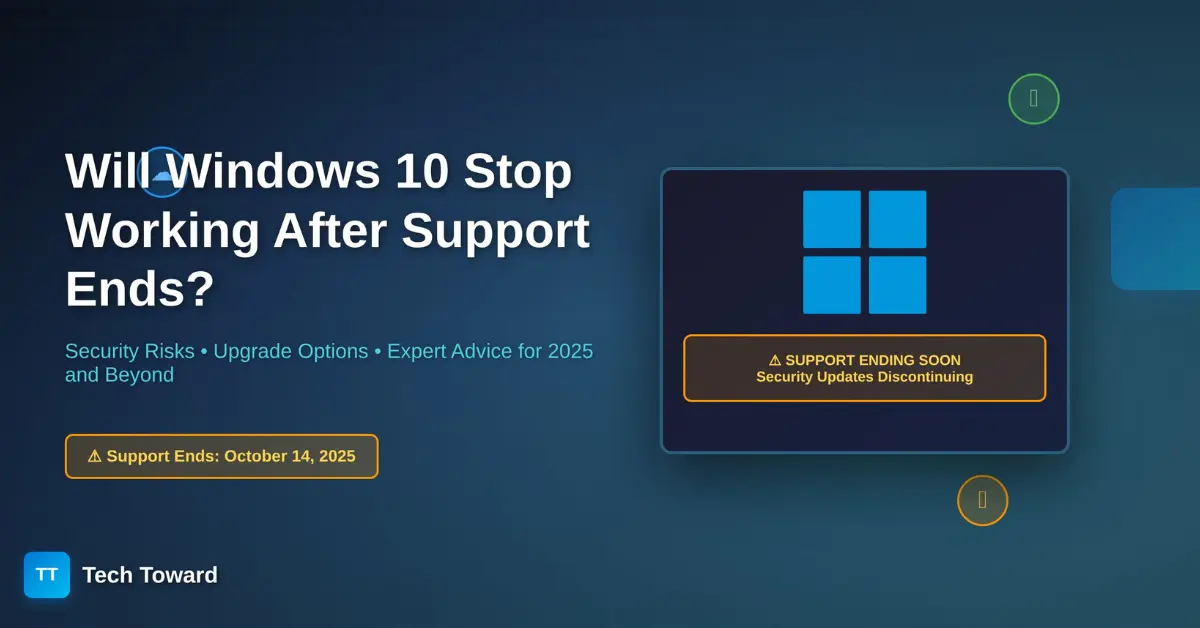Short answer: No. Windows 10 will continue running normally after October 14, 2025, but Microsoft will stop providing security updates, bug fixes, and technical support. Your PC won’t shut down or “expire,” yet over time it will become less secure and less compatible with new software and hardware.
What “End of Support” Really Means
When Microsoft ends support, it simply stops maintaining the operating system. Windows 10 will still boot, run apps, and connect to the internet. The change is like a car warranty expiring—you can still drive, but repairs are now on you.
After October 14, 2025, Microsoft will no longer deliver:
- Security updates against new threats
- Bug fixes or reliability improvements
- Feature updates or new capabilities
- Official tech support
Microsoft ends support to focus on modern technology, uphold higher security standards, and streamline development. Since Windows 10 launched in 2015, it will have received a full decade of updates by 2025.
What Happens After October 14, 2025
Your PC Keeps Working
There’s no kill switch. On October 15, your computer will look and behave exactly the same. Apps, files, and peripherals will still function—just as millions of people continued using Windows XP after its 2014 retirement.
The Real Issue: Security
Once updates stop, new vulnerabilities remain permanently open. Cybercriminals target unsupported systems because their weaknesses are public knowledge. You’ll face greater risks of:
- Ransomware and malware infections
- Data theft or identity fraud
- Botnet participation
- Complete system compromise
Compatibility Problems
Over time, newer software and hardware will stop supporting Windows 10. Web browsers like Chrome and Firefox will eventually end updates, making secure web use difficult. New printers, GPUs, or apps may lack drivers or installers for the OS.
Lessons from Past Windows Versions
Windows XP (ended 2014): Millions kept using it, but unsupported systems were hit by major outbreaks such as WannaCry (2017). Some users minimized risk by staying offline or isolating the machine.
Windows 7 (ended 2020): More gradual decline. It remained usable for years, but modern browsers and programs have since dropped it, leaving users increasingly vulnerable.
Your Options Before 2025
1. Upgrade to Windows 11 (Recommended)
Windows 11 is Microsoft’s current platform with support extending into the 2030s.
Pros:
- Continuous security updates and modern features
- Better gaming (DirectStorage, Auto HDR)
- New design and performance improvements
Cons:
- Strict requirements (TPM 2.0, UEFI + Secure Boot)
- Older PCs may not qualify
- Interface changes
Check compatibility: Use Microsoft’s PC Health Check tool.
If eligible, upgrades are free for most licensed Windows 10 users.
2. Stay on Windows 10 (with Precautions)
If you can’t upgrade immediately, tighten security:
- Use reputable antivirus software
- Keep Windows Defender active
- Maintain strong firewalls
- Avoid suspicious sites and downloads
- Back up data frequently
- Use a standard (non-admin) account
- Go offline for sensitive tasks
Who can safely wait:
- Users of older PCs for basic offline work
- Those running legacy apps
- People planning to replace hardware soon
3. Extended Security Updates (ESU)
Microsoft may offer paid ESUs for businesses, as it did with Windows 7. That program cost $25–$200 per device per year, doubling annually. Consumer availability for Windows 10 is unconfirmed—keep an eye on Microsoft announcements.
4. Switch to Linux or macOS
Linux distributions such as Ubuntu, Linux Mint, or Zorin OS are free, secure, and supported for years.
Pros:
- Zero cost, frequent updates, privacy-friendly
- Runs well on older hardware
Cons:
- Learning curve
- Some Windows-only software and games may not run natively
macOS is another stable option but requires Apple hardware.
How to Upgrade to Windows 11
Step 1 – Check Compatibility
Run the PC Health Check app. Typical requirements:
- TPM 2.0 and Secure Boot enabled
- 8th-gen Intel or newer / 2nd-gen Ryzen or newer CPU
- ≥ 4 GB RAM and 64 GB storage
Step 2 – Enable Security Features
Enter BIOS/UEFI (press F2/F10/DEL at startup). Enable TPM /PTT/fTPM and Secure Boot, then save and exit.
Step 3 – Back Up Everything
Use Windows Backup, an external drive, or cloud storage before upgrading.
Step 4 – Install Windows 11
Choose one of these methods:
- Windows Update: Settings → Update & Security → Check for updates → “Upgrade to Windows 11”
- Installation Assistant: Download from Microsoft and follow prompts
- Media Creation Tool: Create bootable USB drive for clean install
Step 5 – After the Upgrade
Install updates, verify activation, update drivers, and restore settings and apps.
Recommendations by User Type
Home Users
Prioritize online safety—personal data, banking, and photos are at risk. If your PC supports Windows 11, upgrade within 6 months. If not, consider a new or refurbished Windows 11-ready PC ($300–$400).
Small Businesses
Unsupported systems can violate data-protection regulations. Audit all PCs, test critical software on Windows 11, and plan phased upgrades. Budget now to avoid last-minute rushes.
Gamers & Creators
Modern rigs (built 2018+) usually meet Windows 11 specs. Upgrade for performance boosts and newer DirectX features.
Enterprises & IT Pros
Use pilot deployments, test business apps, and plan company-wide transitions with Endpoint Manager and Group Policy. Microsoft will likely provide ESU options for enterprise customers.
Common Myths & Facts
| Myth | Reality |
| “Microsoft will force Windows 11 on me.” | No. You choose when to upgrade; unsupported PCs won’t get forced installs. |
| “Windows 10 will stop working.” | False. It keeps running indefinitely, just without updates. |
| “I’ll lose files during upgrade.” | The upgrade preserves data, though backing up is wise. |
| “Antivirus alone keeps Windows 10 safe.” | Not entirely—antivirus can’t patch OS-level flaws. |
| “Windows 11 is slower.” | On supported hardware, performance equals or surpasses Windows 10. |
Cost Comparison
Upgrading to Windows 11
- License: Often free ($0–$199 max)
- Time: 2–4 hours
- New PC (if needed): $300–$1,000+
Total: $0–$1,000 depending on hardware.
Staying on Windows 10
- Upfront cost: $0
- Hidden costs: antivirus ($40–$120 / yr), potential data breaches ($500+), possible ESU fees, productivity losses.
Long-term, risks can outweigh short-term savings.
Switching to Linux
- OS: Free
- Learning curve: 10–40 hrs
- Extra software: $0–$200
Excellent low-cost option for older hardware.
Extending the Life of Your Windows 10 PC
Hardware Tips
- Clean dust; prevent overheating
- Upgrade RAM or swap in an SSD for speed
- Replace thermal paste on older CPUs
- Monitor temps with HWMonitor or Core Temp
Software Optimization
- Remove bloatware
- Disable unneeded startup apps
- Use Disk Cleanup and defragment (HDDs only)
- Keep drivers updated
Security Hardening
If staying on Windows 10:
- Use layered antivirus and firewall protection
- Enable browser ad-blocking and password managers
- Turn on two-factor authentication everywhere
- Operate daily as a non-admin user
- Isolate old PCs on a separate network
Planning Your Next Move
Ask yourself:
- Budget: Can I upgrade or replace hardware soon?
- Use case: Basic tasks or demanding workloads?
- Risk tolerance: Am I comfortable with weaker security?
- Longevity: How long must this device last?
Then build a roadmap:
- Assess current system and software.
- Research options—Windows 11, Linux, or new hardware.
- Set a timeline (ideally before mid-2025).
- Test first, then migrate gradually.
FAQs
Will Windows 10 stop working after 2025?
No. It keeps running but loses updates and support, raising long-term security risks.
Can I still browse the internet?
Yes, but browsers and sites will grow unsafe or incompatible over time.
Is Windows 11 free?
Usually yes for genuine Windows 10 users.
What if my PC doesn’t meet Windows 11 requirements?
Try enabling TPM / Secure Boot, stay on Windows 10 with caution, buy a new PC, or install Linux.
How long can I safely stay on Windows 10?
Experts recommend upgrading within 6–12 months after October 2025.
Will antivirus protect me?
Partially. It can’t patch OS flaws, so it’s not a full safeguard.
Can businesses pay for extra updates?
Likely via a paid ESU program—details expected closer to 2025.
Will my software still work on Windows 11?
Most will, but check compatibility for older apps.
Is Linux a real alternative?
Yes—secure, fast, and free, though not perfect for every Windows-only workflow.
What if I can’t afford new hardware?
Keep Windows 10 locked down, use strong antivirus, and start saving for an upgrade or explore Linux.
The Bottom Line
The end of Windows 10 support is not a shutdown date—it’s a turning point. Your PC will still function, but without security patches, risks accumulate quickly. Whether you:
- Upgrade to Windows 11 for full protection,
- Use Windows 10 temporarily with strict safeguards, or
- Adopt Linux for a fresh, free start,
the key is planning ahead. Don’t wait for October 2025—test your options now, back up your data, and choose the path that fits your budget, hardware, and comfort level.
Change can be inconvenient, but it’s also a chance to modernize and secure your digital life. Prepare early, act thoughtfully, and your transition beyond Windows 10 will be smooth, safe, and future-ready.


